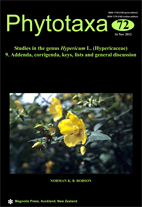Abstract
Part 9 concludes this monographic series of papers on the genus Hypericum. The first chapter contains: (i) extended additions to, revisions of, and comments on the systematic parts (Parts 3–8), including a detailed revision of the larger part of Sect. 3. Ascyreia with a revised key; (ii) shorter additions and corrections to all parts; (iii) a detailed enumeration of the sections of the genus with their perceived interrelationships, and (iv) a revised key to these sections.
In the second chapter, some of the characters treated in Part 2 are reconsidered, but not chemotaxonomy, which is discussed in an appendix contributed by Sara Crockett. The relationships within and between sections of each of the three groups of the genus are then considered, followed by an interpretation of them in terms of distribution, leading to a description of the disjunctions in distribution thereby revealed. This is followed by a discussion.of the various means of dispersal that may have brought about these distribution patterns. In the final section on the evolution of the genus, Santomasia is re-incorporated in Hypericum, but Lianthus and Triadenum continue to be excluded. A consideration of the relationships of the Hypericaceae to the rest of the Clusioid clade leads to a description of the probable characters of the primitive Hypericum.
New taxa and names appearing in this Part are: Sect. 1a: Hypericum sect. Santomasia. Sect. 1: H. smithii. Sect. 3: H. reptans subsp. ogisui; H. rotundifolium; H. oxyphyllum; H. calycinum forma luteum; H. fanjingense; H. hookerianum ‘Rodgersii’; H. lagarocaule. Sect. 5: H. × inodorum ‘Limpsfield’. Sect. 14: H. × caesariense. Sect. 18: H. linarioides Bosse subsp. alpestre. Sect. 28: Hypericum sect. Tripentas. Sect. 29: H. monroi; H. graciliforme; H. marahuacanum subsp. compactum.

